In today’s data-driven world, the Internet of Things (IoT) is revolutionizing how we manage and optimize resources. With the growing demand for sustainability and efficiency, the ability to monitor energy and water usage in real-time has become a necessity rather than a luxury. Enter the Intelligent Industrial Asset Monitoring System—a cutting-edge solution designed to track, analyze, and optimize resource utilization with unparalleled precision.
This blog delves into the core of this innovative project, exploring its concept, key components, implementation process, and the transformative benefits it offers across various industries.
What is & Why Do We Require AWS IoT Core & AWS IoT SiteWise?
The Industrial Asset Monitoring System harnesses the capabilities of AWS IoT Core and AWS IoT SiteWise to achieve secure connectivity, efficient data processing, and actionable insights. These AWS services play a pivotal role in the system’s success.
What is AWS IoT Core?
AWS IoT Core is a fully managed cloud service that allows IoT devices to securely connect, communicate, and exchange data with other devices and cloud applications.
Key Features of AWS IoT Core:
- Secure Communication: Encrypts data and ensures authentication for every device connected to the system.
- Real-Time Data Handling: Enables the continuous flow of real-time data from devices like Flowmeters and EnergyMeters to the cloud.
- Scalability: Supports a large number of devices, making it ideal for both small setups and large-scale industrial applications.
How AWS IoT Core Helps the Monitoring System?
AWS IoT Core acts as the central hub for the monitoring system, allowing data from the Flowmeter and EnergyMeter to be securely transmitted and processed in real-time. This ensures:
- Instant insights into resource usage.
- Reliable alerts for anomalies like leaks or energy surges.
- Seamless device management for efficient operation.
What is AWS IoT SiteWise?
AWS IoT SiteWise is a managed service designed to simplify the collection, organization, and analysis of industrial IoT data. It helps create a structured view of operations for better decision-making.
Key Features of AWS IoT SiteWise:
- Data Modeling: Allows digital representation of physical assets (e.g., Flowmeters and EnergyMeters).
- Real-Time Dashboards: Provides live visualizations of critical metrics like flow rate and energy consumption.
- Actionable Analytics: Helps identify inefficiencies, optimize processes, and improve resource management.
How AWS IoT SiteWise Helps the Monitoring System?
AWS IoT SiteWise processes and organizes the data collected through AWS IoT Core into intuitive dashboards and analytical models. This allows the monitoring system to:
- Display real-time data for instant feedback.
- Highlight trends and inefficiencies to optimize resource utilization.
- Enable remote monitoring, empowering users to make informed decisions anytime, anywhere.
Why These Services Are Essential for the System ?
The combination of AWS IoT Core and AWS IoT SiteWise offers a seamless framework for the Flowmeter and EnergyMeter Monitoring System by:
- Ensuring Secure and Reliable Communication: Protecting sensitive data and maintaining system integrity.
- Providing Real-Time Monitoring and Alerts: Enabling proactive issue resolution and efficient resource usage.
- Scalability and Flexibility: Adapting to the needs of diverse applications, from residential to industrial.
- Streamlining Data Visualization and Analysis: Offering easy-to-understand insights through user-friendly dashboards.
By integrating these AWS services, the monitoring system transforms raw data into actionable insights, driving operational efficiency and sustainability like never before.
Why IoT in Resource Monitoring System ?
Efficient resource management has become a cornerstone of sustainability and operational excellence. However, traditional methods of monitoring water, energy, and other resources often fall short in delivering the precision and immediacy needed in today’s fast-paced world. This is where the Internet of Things (IoT) steps in, transforming resource monitoring with unparalleled advantages:
- Real-Time Data Insights : IoT enables continuous tracking of critical parameters, such as energy consumption and water flow, through connected sensors. These real-time insights allow businesses and homeowners to make informed decisions instantly.
- Proactive Issue Detection : IoT-powered systems can send alerts for anomalies like leaks, overconsumption, or equipment faults, preventing costly downtimes or wastage.
- Enhanced Operational Efficiency : By analyzing IoT data, organizations can optimize processes, reduce waste, and improve energy efficiency, ultimately lowering operational costs.
- Scalability and Integration : IoT systems are designed to scale effortlessly. Whether you’re monitoring a single home or an industrial facility, IoT platforms like AWS IoT Core can integrate multiple devices into a centralized dashboard for seamless management.
- Remote Accessibility : With cloud-based platforms, IoT allows users to monitor and control resource usage from anywhere in the world, ensuring convenience and control.
- Sustainability and Compliance : IoT helps meet environmental sustainability goals by enabling smarter resource usage and compliance with regulations through accurate reporting and analysis.
Key components of the IoT Based Monitoring System:
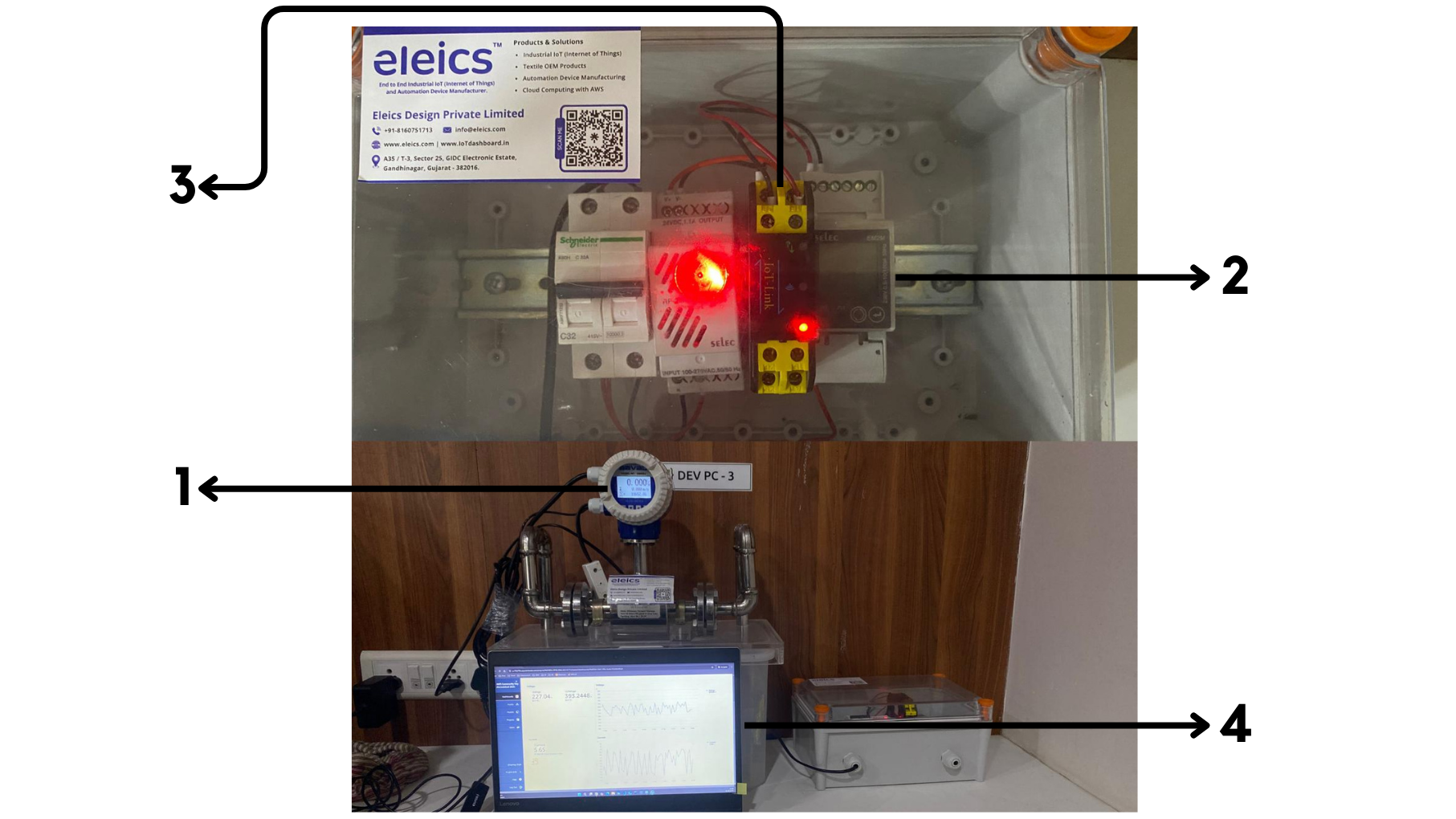
- Flowmeter:
The Amag1 Digital Flowmeter offers precise water flow monitoring with integrated IoT capabilities. It features a cloud-based dashboard for real-time insights into flow rates and consumption, along with instant email/SMS alerts for anomalies like leaks. Its easy installation and remote monitoring make it ideal for industries like agriculture, manufacturing, and water utilities, ensuring efficient and responsible water resource management. - Energymeter:
The EM2M-1P-C-100A EnergyMeter delivers high-accuracy energy monitoring for 1-phase systems, measuring AC/DC currents up to 100A. With RS485 Modbus communication and configurable pulse outputs, it integrates seamlessly with external systems. CE and MID-certified, it meets global standards for precision and reliability, supporting diverse energy management applications. - IoT-Link:
A compact and robust IoT device, the IoT-Link enables seamless connectivity for retrofitting industrial systems. With analog/digital I/O channels, RS485 communication, and durable construction, it operates in challenging environments. The IoT-Link supports efficient data transmission over long distances, bridging traditional systems with modern IoT solutions.. - Cloud Platform:
AWS IoT Core and AWS IoT SiteWise form the backbone of the cloud integration. IoT Core ensures secure, real-time device connectivity and data management, while SiteWise organizes and analyzes industrial data for actionable insights. Together, they provide robust tools for optimizing operations and monitoring performance across industries.
Which Connections & Protocols are used and Why ?
- MQTT:
MQTT (Message Queuing Telemetry Transport) is a lightweight and efficient messaging protocol tailored for IoT systems. Its publish-subscribe architecture ensures secure and reliable communication between devices and the cloud, even in networks with limited bandwidth or high latency. By minimizing resource usage, MQTT enables real-time data transmission, making it ideal for applications requiring rapid and consistent updates, such as industrial monitoring, smart homes, and connected devices. - Wi-Fi 2.4 GHz:
Wi-Fi 2.4 GHz is a widely supported wireless frequency known for its extended range and robust connectivity, even in challenging environments. Its compatibility with IoT devices ensures seamless integration and uninterrupted communication across diverse applications. With the ability to penetrate walls and maintain stable connections over longer distances, Wi-Fi 2.4 GHz is well-suited for smart systems, enabling efficient data transfer and reliable performance in industrial, residential, and commercial settings.
Step-By-Step Implementation
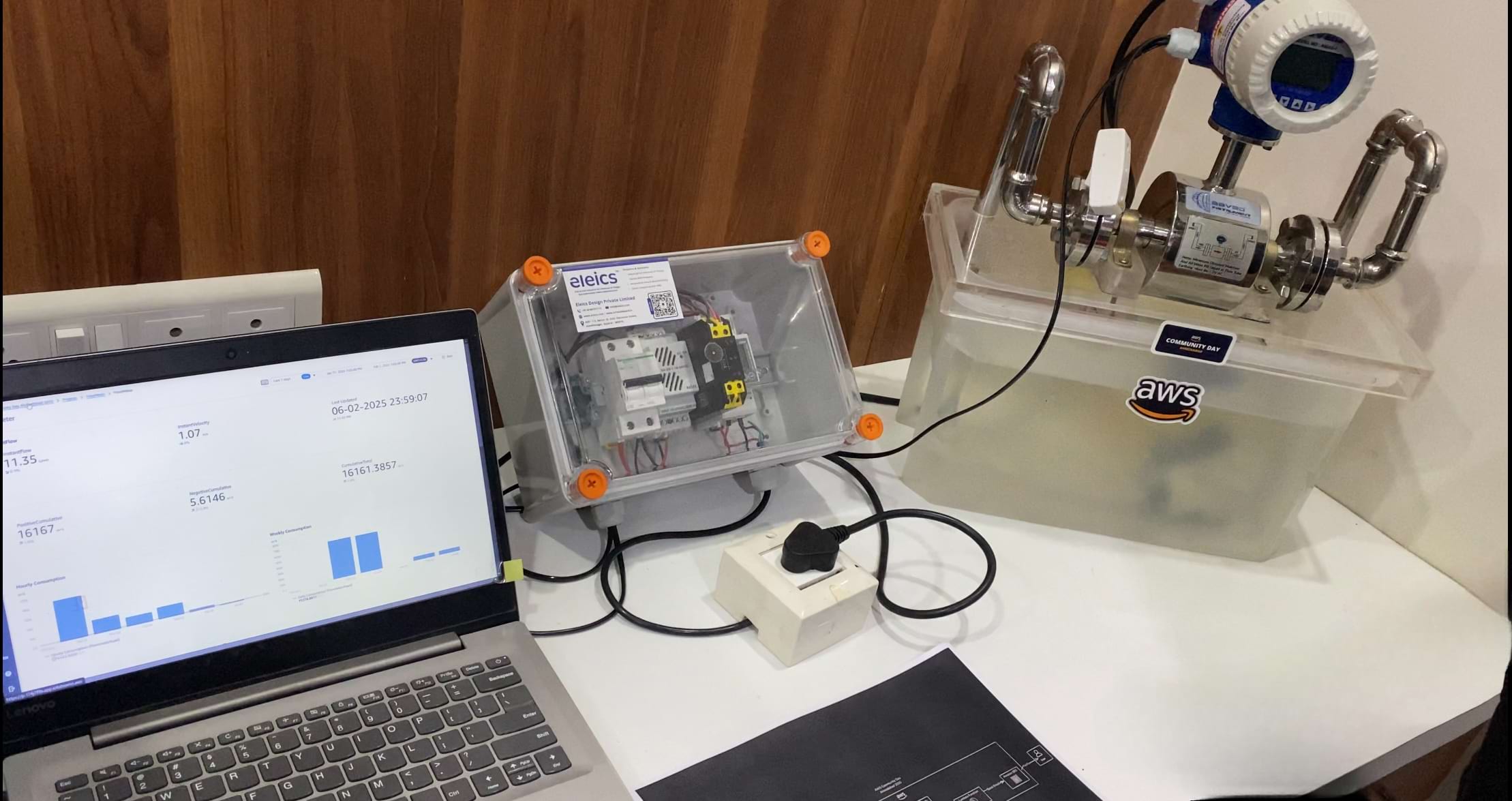
- Hardware Setup:
The flowmeter and energymeter sensors were connected to the IoT-Link device, which served as a gateway for transmitting data to the cloud via Wi-Fi (2.4 GHz) using the MQTT protocol. Proper wiring, electrical connections, and data verification ensured seamless communication and reliable data acquisition. - Software Development:
Custom firmware was developed for the IoT-Link device to process sensor data into meaningful metrics, such as flow rates (liters per minute) and energy usage (kWh). The firmware integrated MQTT for secure data transmission to AWS IoT Core. - Cloud Integration:
AWS IoT Core was configured to manage device communication with security certificates and MQTT topic subscriptions. AWS IoT SiteWise was used to structure, store, and analyze data, enabling real-time insights into water flow and energy consumption. - Data Visualization:
Interactive dashboards were built using AWS IoT SiteWise, displaying key metrics such as real-time flow rates, energy usage, and alerts for anomalies. These dashboards enabled intuitive data exploration and operational insights. - Testing and Optimization:
Extensive testing ensured accurate and real-time performance under real-world conditions. Firmware optimizations reduced latency, ensured data accuracy, and minimized network traffic. The system was robustly configured to handle interruptions, ensuring reliability and scalability for efficient water and energy monitoring.
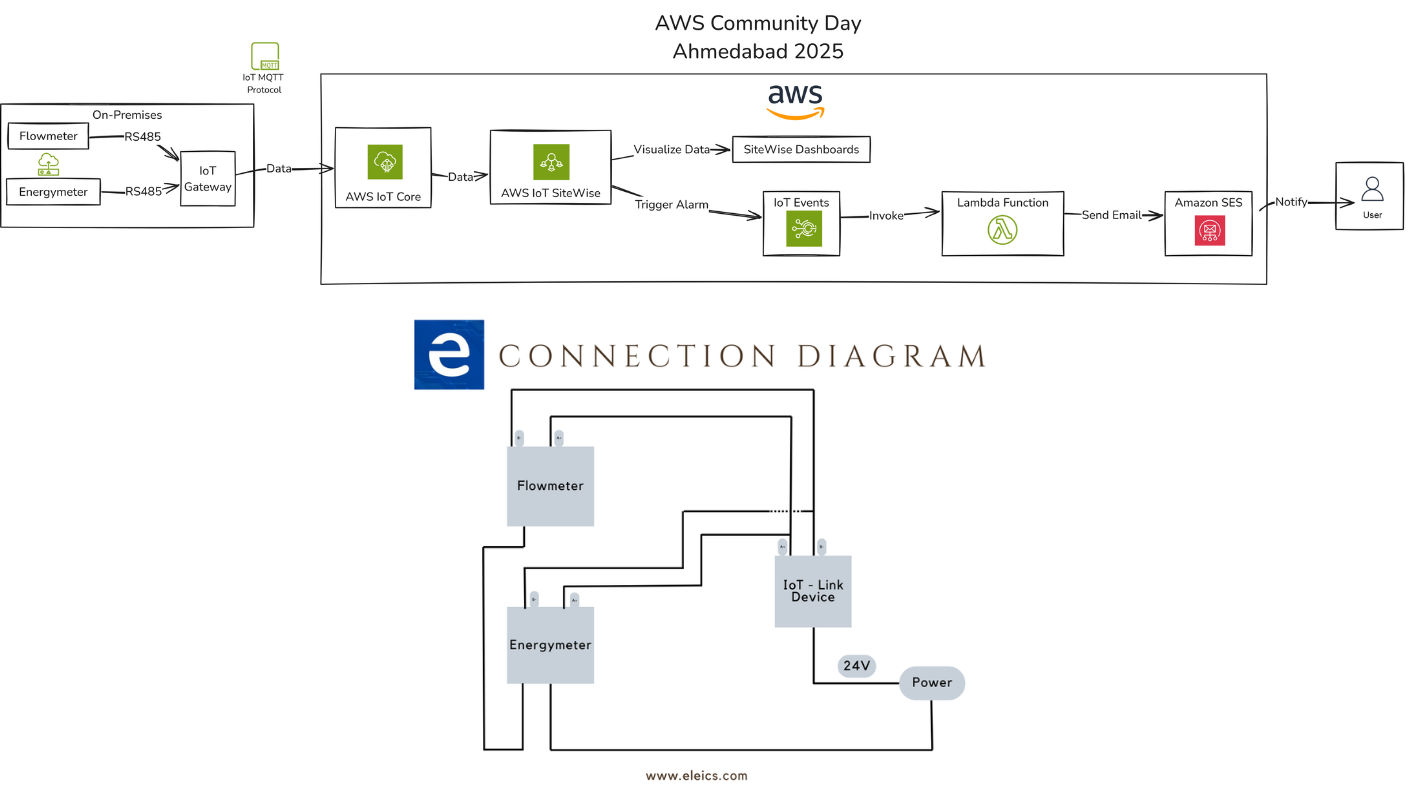
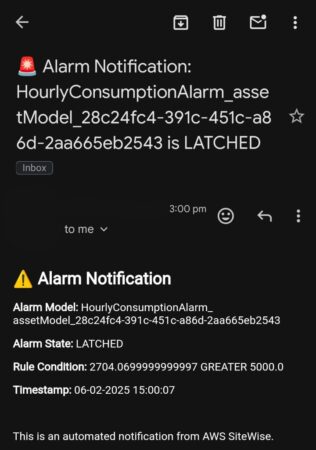

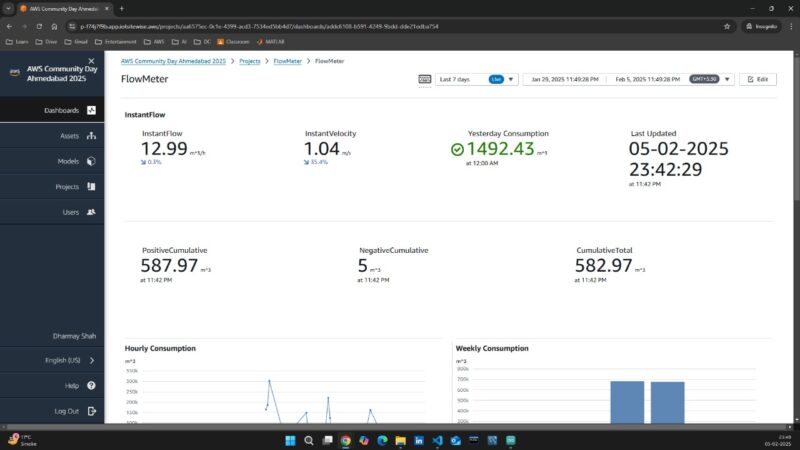
What will be the process flow ?
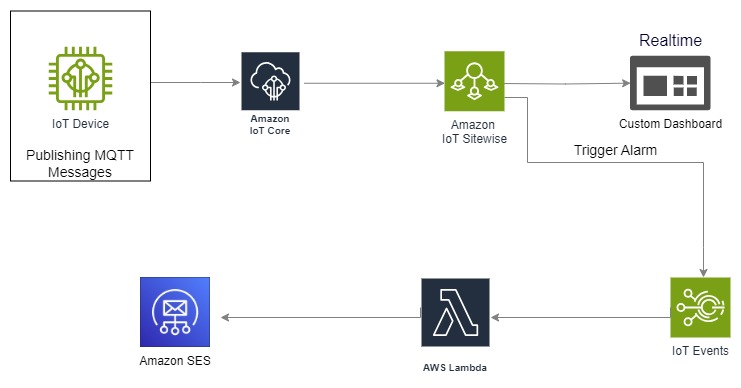
This flow diagram outlines an IoT-based architecture that seamlessly collects, processes, and visualizes real-time data while providing automated alert mechanisms. Let’s walk through the process step by step:
- Data Collection from IoT Devices : The IoT device continuously publishes data such as voltage, current, power factor and frequency from Energymeter and Flow rate, Velocity, Positive Cumulative, Negative Cumulative, Total Cumulative from Flowmeter using the MQTT protocol. This data is ingested into Amazon IoT Core, where it becomes available for further processing. To enable this data flow, subscriptions must be established within IoT Core to capture and manage the raw telemetry data.
- Data Transformation in IoT SiteWise : The raw data from IoT Core is routed to Amazon IoT SiteWise, where it undergoes transformation and addition of assets of what data to be displayed on dashboard. By applying mathematical functions and user-defined formulas, insights such as hourly usage costs are derived. These processed insights are visualized on a customized dashboard for the user, providing actionable information in real-time.
- Alarm Triggering via IoT Events : When certain conditions exceed predefined thresholds (e.g., abnormal voltage levels), alarms are triggered in IoT Events. These thresholds are designed to detect potential issues in the system.
- Automated Alert Mechanism : Upon alarm activation, IoT Events initiates an AWS Lambda function. This function processes the alarm details, such as device identity and location, and sends an immediate alert email to the administrator via Amazon Simple Email Service (SES). This automated workflow ensures quick action in response to critical events.
Live Demonstration Insights : Real World Application
Industrial IoT: Real-Time Data from Flow and Energy Meters to AWS IoT Core at AWS Community Day Ahmedabad
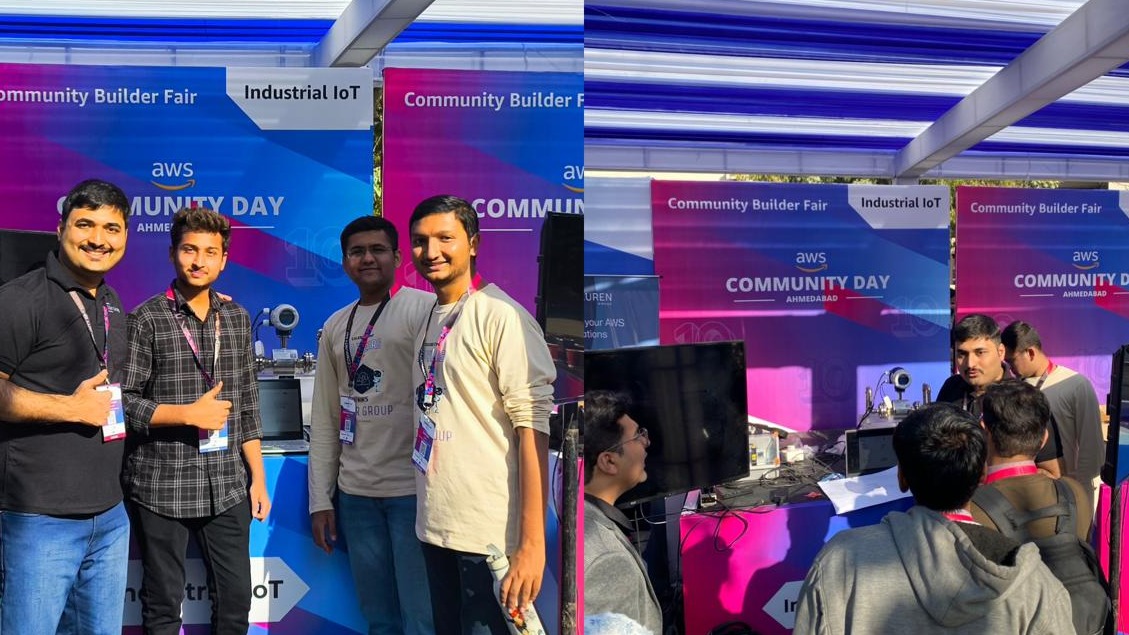
At AWS Community Day, we had the opportunity to showcase a live demonstration of our Industrial IoT project involving real-time data collection from flow meter and energy meter. The demonstration provided a hands-on experience, allowing attendees to see the solution in action and understand how it integrates seamlessly with AWS IoT Core and AWS IoT SiteWise.
We began by explaining the project’s architecture using a detailed flow diagram, which highlighted the key components of the system. The IoT-Link device served as the central hub for gathering data from the flow meter and energy meter. As the live demonstration unfolded, we showed how the IoT-Link securely transmitted the data through the MQTT protocol to AWS IoT Core, enabling real-time data transfer.
The flow diagram illustrated the entire process, from the initial data collection by the IoT-Link from the meters, through the data transfer over Wi-Fi to the AWS cloud. This helped attendees understand how the data was securely and efficiently managed and visualized in AWS IoT SiteWise for actionable insights into energy consumption and water flow monitoring.
Throughout the session, we emphasized the real-world applications of this technology in industries like manufacturing and utilities. The ability to monitor critical parameters remotely, combined with real-time alerts, energy optimization, and seamless integration into AWS services, offers immense value to businesses looking to leverage IoT for operational efficiency and sustainability.
By providing this live, interactive demonstration, we not only showcased the technical workings of the project but also emphasized the immense potential of Industrial IoT solutions for improving data-driven decision-making in various sectors.
Here are the Glimpse of the display of the Project:
Conclusion:
The Flowmeter and Energymeter Monitoring System exemplifies the potential of IoT to revolutionize resource management. By providing real-time monitoring and actionable insights, this system empowers users to make informed decisions about resource usage, leading to reduced waste and increased efficiency. Its adaptability to diverse environments—from industrial plants to smart homes—makes it a versatile solution with broad applications.
Beyond its immediate functionality, this project serves as a foundation for innovation in predictive analytics, automation, and energy optimization. With advancements in AI and cloud computing, such systems can evolve into comprehensive resource management platforms, driving sustainability and operational excellence. The journey of building this system underscores the importance of integrating technology with purpose, highlighting how IoT can address modern challenges effectively and intelligently.
About Author:
Yash Shah | IoT Enthusiast & Student at G H Patel College of Engineering & Technology, Gujarat, India.
Dharmay Shah | Student and AWS Cloud Captain at Adani University, Ahmedabad, Gujarat, India.
Bhavesh Gohel | AWS Community Builder – DevTools, AWS Certified, Co-Founder & CTO – Eleics Design Pvt. Ltd.

